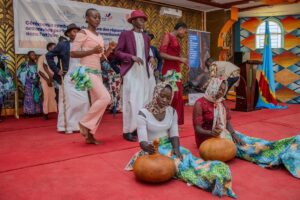Castle Bravo is the codename for the largest test of a thermonuclear bomb ever made by the US. The test was 70 years ago, on March 1, 1954, but the disaster is still happening. The story of Castle Bravo is not one of scientific triumph or successful cold war deterrence. It is a story of how life on the Marshall Islands was uprooted, lands contaminated, and people left to struggle with the consequences – for generations. 1 March is now a national day of mourning and remembrance, joined by diaspora Marshallese working for nuclear justice elsewhere in the world.
Friday, 1 March 2024, marks 70 years since the Castle Bravo test and 70 years of people living with the consequences. In marking this day of remembrance, Melissa Parke, Executive Director of ICAN is calling for urgent action:
“The nuclear-armed states which have carried out nuclear tests have paid inadequate attention to the lasting effects of their tests on people and the environment. Because testing has been carried out predominantly in colonised states or areas populated by Indigenous peoples, these effects have to be addressed, not just because of their impact on people’s health and wellbeing, but also as an urgent matter of social justice.”
What was the Castle Bravo test?
Under the codename Castle Bravo, the US tested a thermonuclear bomb with a yield of 15 megatons at Bikini Atoll. This bomb had a yield of almost a thousand Hiroshima bombs. It evaporated two whole islands and part of a third, and their radioactive ashes fell over nearby islands.
The U.S. military evacuated people from some islands, removing them from their homes and lands. Others were not even warned, even though the risks were known to the military, andpeople on Rongelap, Ailinginae and Utrik Atolls were evacuated only two and a half days later, after being exposed to near-lethal doses of radiation.
The long-term effects of US nuclear tests on Marshallese people and environment
The United States carried out 67 nuclear weapon tests in the Marshall Islands between 1946 and 1958, with severe health effects for the Marshallese population. Cancer risk increasedsignificantly and the people saw alarmingly high rates of infertility, stillbirths, miscarriages, and congenital birth defects.
The nuclear tests produced widespread radiological contamination, which continues to pose an active threat to people and the environment. The radiation still makes atolls like Bikini inhabitable. The Marshall Islands lack the necessary medical infrastructure to treat the many complex cancer cases, and many have to travel overseas for treatment.
The radiation has severely impacted the food supply, as the contamination travels through ecosystems, making plants and crops inedible. As a result, the Marshall Islands depend on imported food that is often highly processed, causing obesity and making diabetes the number one cause of death among the Marshallese.
It has also forced changes in cultural practices, like when people were moved from atolls with lagoons where they used to fish, to atolls without lagoons where they were not able to catch and live off the fish. The loss of cultural heritage, practices and memory is another impact of nuclear weapons testing.
Addressing nuclear colonialism and the lack of justice for survivors
Nuclear weapons have disproportionately been tested on colonised and Indigenous lands and peoples. The double dehumanisation of nuclear tests and the subsequent medical experiments on human beings living near the tests sites shows the inhumane nature of nuclear weapons, and the continuance of this nuclear colonialism is illustrated by the lack of adequate environmental remediation or assistance to the victims.
Marshall Islanders protested the tests from the start. The last test was conducted in 1958, and since then, they have been demanding reparations and justice. In the 1980s, the Nuclear Claims Tribunal was established, through which Marshallese people affected by the testing could apply for financial compensation. But the US only provided $150 million for the fund, and refuses to supply more, despite the billions of awarded damages still unpaid.
The few efforts to remediate the environment that did take place fell drastically short of what was needed. To make matters worse, the US left large amounts of nuclear waste in one of the bomb craters. The crater was not lined at the bottom, unlike the waste dumping sites in the US. Additionally, nuclear waste was shipped there from nuclear tests in the US. The crater is known as Runit dome, and it is at risk of cracking from lack of maintenance, and from rising sea levels caused by climate change over the low-lying Marshall Islands.
How the UN Nuclear Weapons Ban Treaty provides a path forward
“The UN Treaty for the Prohibition of Nuclear Weapons (TPNW), is the best instrument for ensuring nuclear justice because it both bans nuclear weapons so that they can never be used again, and mandates states to assist the communities affected by the use and testing of these weapons in the past and to remediate contaminated environments” says Melissa Parke, Executive Director of ICAN.
The TPNW, in force since 2021, is the first treaty of its kind to include such obligations:
- Article 6 of the TPNW requires states parties to provide victim assistance and environmental remediation to individuals and areas affected by the use or testing of nuclear weapons.
- Article 7 requires all states parties in a position to do so to provide assistance to affected states parties and to victims themselves.
The work is led by Kazakhstan and Kiribati, two countries in which nuclear weapons were tested. All affected countries should join this Treaty to benefit from the survivor-led cooperative system of assistance and remediation it establishes. The participation of affected communities is crucial in shaping a future without nuclear weapons, and the nuclear-armed states owe it to affected communities to join the TPNW without delay to let the next 70 years be free from the threat of nuclear weapons.




